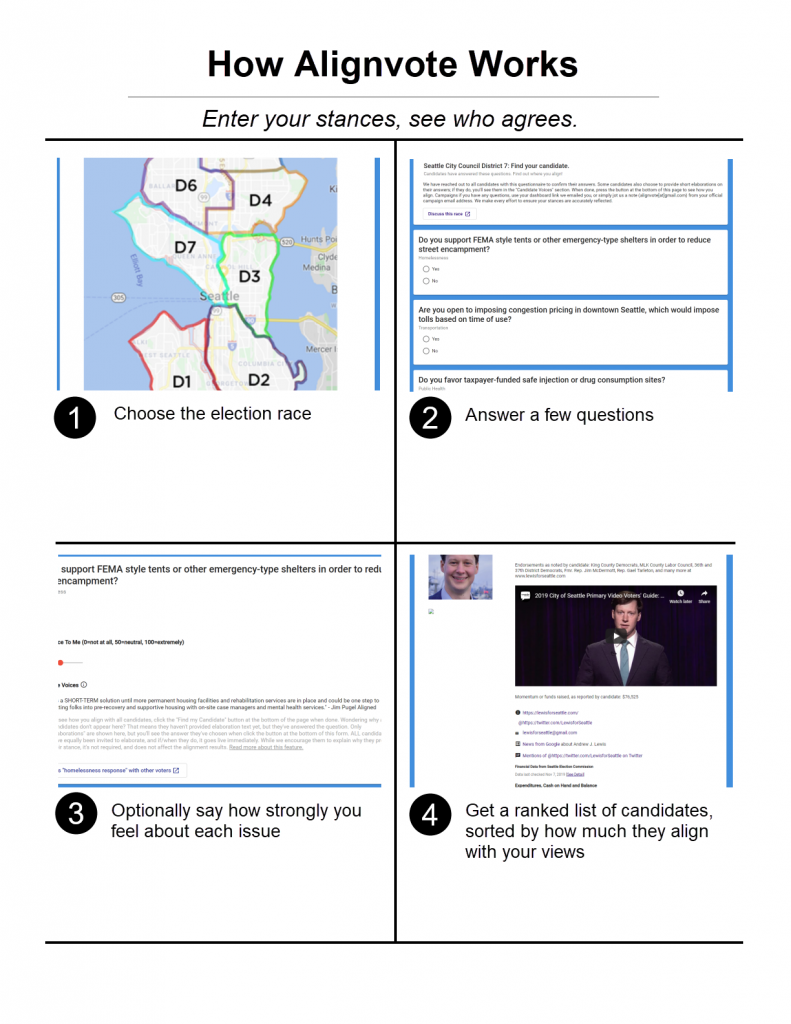The Seattle City Council election took place November 5, 2019. Voters have now cast their ballots.
It looks like we may exceed 50% turnout, which is terrific! Ballots are still being counted.
I want to extend my congratulations to the winners, and my personal and sincere thanks to those who offered themselves up for public service, who competed but fell short. It’s extremely hard and courageous to put oneself out there for public service. There were many big and bold ideas put forth by candidates.
Alignvote’s Goals: A More Informed Electorate, Greater Voter Participation
When I announced the beta of Alignvote, I noted that the main goals were a more informed electorate, an easier way to find those candidates who agree with you, and ultimately greater voter participation. I think those goals were in some sense achieved with this project, though they’re very difficult to quantify.
For me and voters who wanted to be more informed without relying heavily upon third-party “endorsements” or intermediaries, it was an unqualified success. Alignvote delivered over 13,000 candidate-voter alignment rankings, and got a lot of good feedback directly via Twitter, email and in-person. We got about fifty candidates to go on-the-record on their stances on controversial issues (where good people can disagree) with relatively little effort once the platform was live. They stated clearly what their stances are and often elaborating on why.
Alignvote was featured on local radio, television and a couple Seattle-area media publications. It was shared frequently.
Where To With Alignvote?
For now, I consider 2019’s Phase I test of Alignvote complete.
Many voters from left, right and center all said that it generally matched their “most aligned” (and also “least aligned”) candidates.
While at least one individual claimed it, no one ever showed any evidence that it provided bias toward one particular candidate or another. This truth became much easier to gain widespread agreement when, a few weeks after going live with the beta (and well before the August Primary), each session started generating its own unique URL (i.e., a session permalink), pointing to the log which showed both their inputs and their outputs. Given this “proof of input and output”, precisely zero voters challenged the accuracy of the resultant rankings given their input. A handful of people were asked to back up their claims of ranking skew; zero did.
That’s not to say there wasn’t legitimate concern or skepticism about Alignvote in its maiden voyage. There was, and I think is, totally legitimate concern expressed about which questions are asked, but that’s true of all endorsement or survey platforms/articles. Plus, I was limited in the launch period to those statements already on record, asked by other parties at other forums. I also wanted to have only about a dozen or so questions maximum, otherwise it would diminish the simplicity goal of the tool.
I also had to start with questions as already posed in public. That’s why the questions varied from district to district — I wanted to rely mostly upon already on-the-record answers to questions just as they were posed. Now that Alignvote has gotten some traction in its first election, it’s possible we can ask some of our own questions in the future.
In Alignvote’s most controversial moment in the first couple weeks after beta rollout, one candidate opted out of the process. That’s one candidate of more than 50. That’s fine, and his stances were removed within 3 hours of his request. He didn’t make it to the November general election.
During a brief Twitter back-and-forth, he lobbed an unsubstantiated claim that when entering his own stances (pretending to be a voter), the platform showed “top alignment” with a different candidate (which I know to be mathematically impossible given how the platform works.) When asked to show any proof of it — e.g., a screen captured recording, he did not not do so. This led me to release a session URL system which carries with it a lookup into a database showing inputs and outputs. No such claim was ever made once this system was put in place (perhaps because it would then be quite easy to show what inputs and outputs were generated.)
There was in fact just one candidate of the fourteen who made it to the general election who didn’t participate in Alignvote by at least confirming their answers via the dashboard. All others who chose not to participate didn’t make it through the primaries to the general election. All tolled, Alignvote got more than 350 on-the-record confirmed stances from candidates out to voters for their comparison, and dozens of elaborations on why they chose the answers they did.
I learned a great deal in this initial phase of the process — about politics, about the reception of such a tool, about technology and more. A provisional patent was filed on some of the unique aspects of the platform.
I plan to do a wrap-up post on Alignvote and the 2019 Seattle City Council races in the next few weeks, once the dust has settled and official winners are declared in all election races.
I hope to take a look at how closely (or not) Alignvote responses matched the actual election results, what issues were “hottest” among Alignvote voters, and more.
The code and platform is ready to go for the next election. But elections don’t happen every day, as you know, so I might be taking the site down to a “ready for the next election” level in the interim.
Which leads me to bigger plans, but to do so, I’ll need help, including inspiration and partnership:
Interested in Bringing a Better Voters Guide To Your City?
I created Alignvote to help voters more quickly identify which candidates agree most with them, particularly in crowded elections where information is there (e.g., in forums, videos, on-the-record statements) but just not very accessible to voters. The platform basically lets you quickly compare YOUR answers to questions with CANDIDATES’ answers to the exact same questions, and see how much you align.
I remain very intrigued by the possibilities of this kind of platform to improve election transparency for the future. I am not interested in revenue opportunities here, but I do think there needs to be some self-sustaining revenue (donation/partnership/etc.) to pay the bills in a sustaining way.
While the technology is pretty straightforward and was written in a very generalized way, to take this platform national, it’s far bigger than just one person.
That is, I know a reasonable amount about the issues at stake in Seattle City politics in 2019, but I know nothing about the issues that Chicago or St. Louis or New Orleans voters face.
So now, I am looking for other volunteers in other districts, nonpartisan election organizations or credible media partners who might want to take the Alignvote voters guide platform to their local races in the next election cycle.
It’s probably a good idea to make Alignvote embeddable in other websites and able to carry other partner brand names, something I’ll be looking into more extensively during this interim period.
I could see Alignvote Voters Guides evolving as a collaborative Open Source effort, and/or as a software as a service (SAAS) platform project which media companies or nonpartisan organizations pay a small fee for X months to build out and manage their own surveys.
Contact Me
Please contact me or jot a comment in the post below if you’d like to explore this.
Financially, it’s been (and will likely continue to be) a donation / labor of love to attempt to bring more transparency to government and voters, particularly in crowded local races, where I think Alignvote is most helpful.
Since there’s presently no revenue associated with this project, it’s an all-volunteer, all-donation effort, and to date, I’ve been the only donor. I’d be very interested in other municipal races using this platform, but would need good-faith editors who are familiar with the issues in the race to be “election editors.” These editors would need to:
- Determine the proper set of initial questions, including identifying ones that are already stated on-record.
- Ensure those questions are as neutrally phrased as possible, or at a minimum come from on-the-record, verifiable statements
- Act as contact points with the local campaigns and press/promotional opportunities
- Help to tie-in with local systems that report things like financial data, campaign contributions, candidate videos and more
- Develop local “district decision maps” like the Seattle Map, helping to point voters to the appropriate election
Candidate Feedback
I’ll be sending each campaign a request for feedback on Alignvote and the process in another few weeks. In the meantime, if you are with a campaign (or a voter), if you have feedback, please don’t hesitate to drop a note to @alignvote on Twitter.
2019 Site and Data Archived
I’ve taken a snapshot of the data as it is on November 7, 2019, two days after the general election. This will remain archived. The next big City elections are happening in about two years, and will begin in about a year. The current plan is to go forward with another round of this platform.
The site will likely stay in “demo mode” for the next few weeks. The input I receive from voters, campaigns and potential partners will heavily influence next steps.
How Alignvote Works
For those who haven’t seen the platform, here’s how it works for voters:

Candidates get emailed a dashboard link, where they can confirm their stances and optionally elaborate upon them. (They can even offer up a question they’d like to see added in the survey.)
The platform takes care of all the workflow automation behind the scenes, giving candidates their own dashboard of results, letting election race editors create the questions and answers, tracking the usage, showing which issues are hottest, and more. The platform largely runs itself once the data is entered. The matching algorithm is simply a distance score, weighted by how much the voter says they care about each issue.
It’s built as a responsive Angular web application, and works on mobile phones as well as desktops. It’s fast and free.

